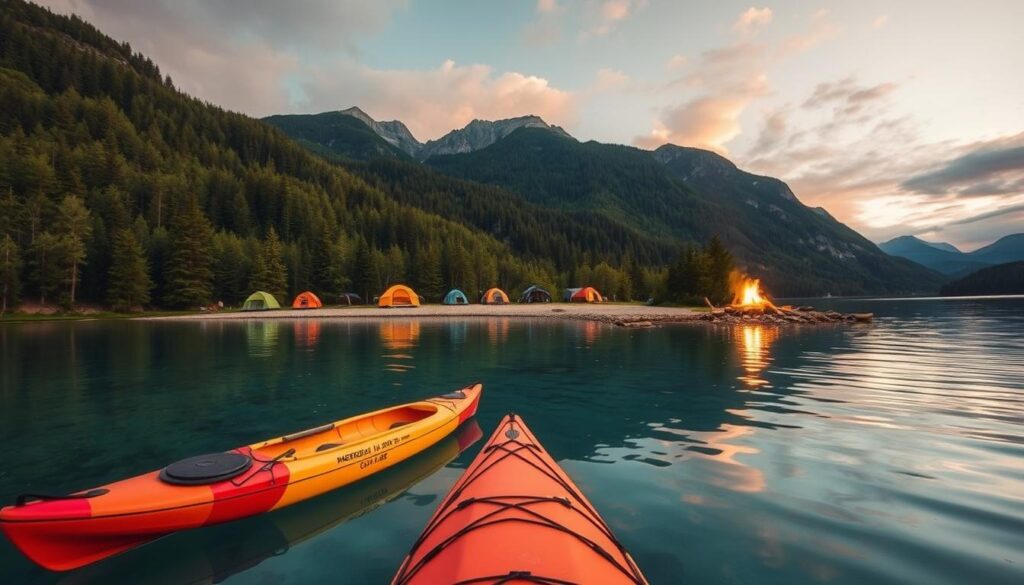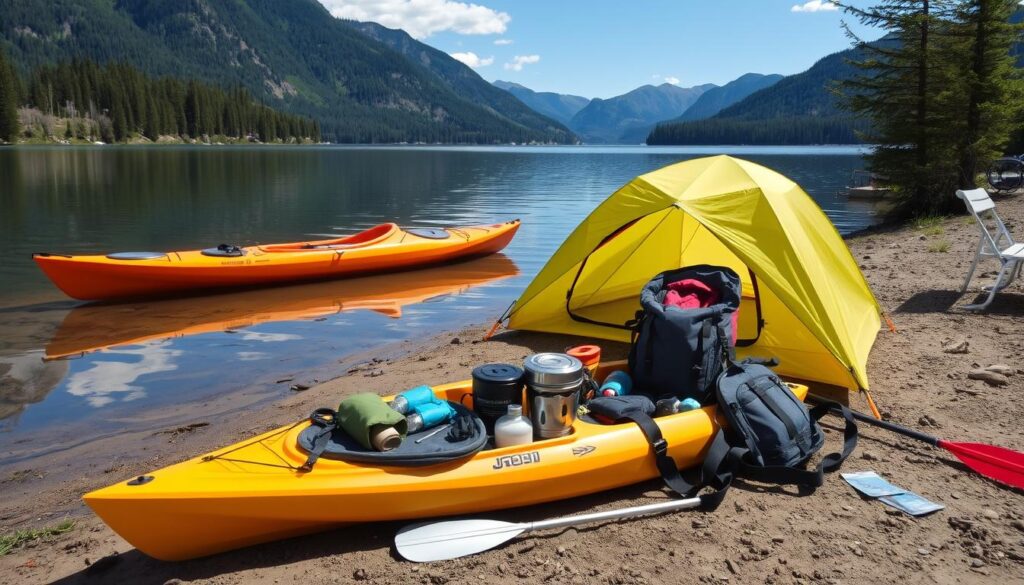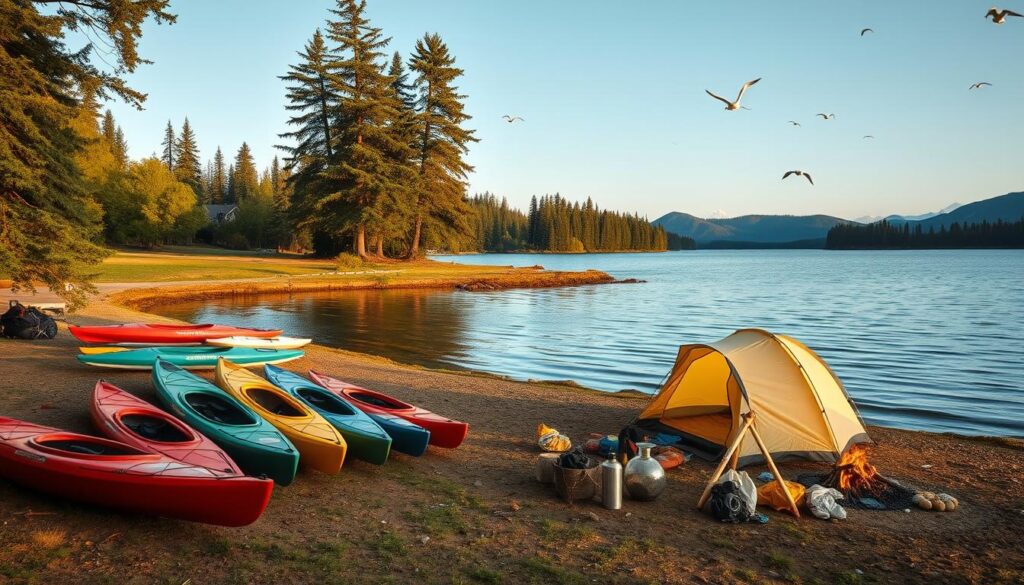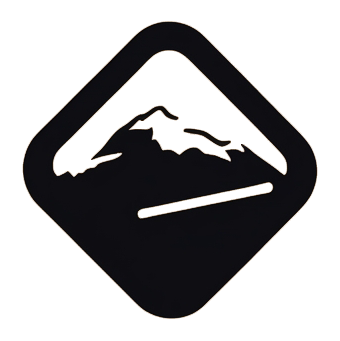
Imagine gliding across crystal-clear waters, your kayak full of essential gear. You’re ready to explore hidden wilderness spaces that few ever see. A kayak camping trip is the ultimate escape from daily life. It combines the thrill of paddling with the peace of outdoor camping.
Kayak camping lets you reach remote places that are hard to get to by land. Whether you’re paddling coastal waterways in Washington state or mountain lakes, these trips offer a deep connection with nature.
Your adventure starts with careful planning. You need to know what gear is essential and pick the right places to go. This guide will help you plan an unforgettable kayak camping trip. It will be full of excitement, challenges, and exploring the wild.
Key Takeaways
- Kayak camping offers unique access to remote wilderness locations
- Proper gear and planning are crucial for a successful trip
- Washington state provides exceptional kayak camping destinations
- Safety and preparation are paramount for outdoor adventures
- Kayak camping allows for immersive nature experiences
Essential Gear for Your Kayak Camping Adventure
Getting ready for a kayak camping trip needs careful planning and the right gear. The right equipment can turn a tough journey into a memorable trip through beautiful kayaking spots.

Waterproof Storage Solutions
Keeping your gear dry is key on a kayak camping trip. Get high-quality dry bags in various sizes for different items:
- Lightweight dry bags for clothes
- Robust waterproof cases for electronics
- Sealed containers for food
“Your gear is your lifeline on the water – protect it wisely.”
Camping Equipment Essentials
Choose camping gear for kayaking that’s light and compact. Look for small tents, sleeping bags, and foldable cooking stuff to save space.
- Ultralight tent (3-4 pounds)
- Compact sleeping bag
- Portable camping stove
- Minimal cookware set
Safety and Navigation Tools
Kayaking campgrounds need thorough safety plans. Essential safety and navigation tools include:
- Personal flotation device
- Marine-grade GPS
- Waterproof communication devices
- Emergency first-aid kit
Preparation is the key to a successful kayak camping adventure. Choose gear that balances functionality, durability, and weight for a fun and safe trip.
Planning Your Perfect Kayak Camping Trip
Planning a kayak camping trip needs careful thought and planning. Whether you’re exploring Washington’s best kayak trips or new waters, start with good research and organization.

First, check your paddling skills and pick places that fit your level. Kayak camping in Washington has many landscapes, from calm waters to tough coastal paths.
- Evaluate your paddling skills and physical fitness
- Research potential kayaking routes and campsites
- Check water conditions and tide schedules
- Obtain necessary permits and understand local regulations
“Preparation is the key to an extraordinary kayaking experience.” – Experienced Paddler
Make a detailed trip plan with daily paddling goals, camping spots, and backup plans. Being flexible is key in water adventures.
| Planning Aspect | Recommended Action |
|---|---|
| Route Selection | Match difficulty to skill level |
| Food Planning | Pack lightweight, non-perishable meals |
| Water Management | Carry water filtration system |
For newbies, think about joining guided kayak camping tours. These tours offer expert guidance, safety, and tips on local waters. Guides can show you the best spots and make sure your trip is safe and fun.
Top Kayak Camping Destinations in Washington State
Washington State is a paradise for kayak campers. It has everything from calm waterways to wild coastlines. No matter your skill level, you’ll find unforgettable spots for kayak camping.
Looking for the best kayak trips? Here are some amazing places for a unique paddling adventure:
Puget Sound Routes
Puget Sound is a treasure trove for kayak campers. It’s full of wildlife and beautiful shores. Highlights include:
- Stunning island passages
- Protected waterways perfect for beginners
- Chances to see marine mammals
Olympic Peninsula Waterways
The Olympic Peninsula is known for its dramatic kayak trips. You can explore:
- Rugged coastlines
- Shores of temperate rainforests
- Impressive sea stacks
San Juan Islands Adventures
The San Juan Islands are a top choice for kayak camping. They offer:
- Safe water routes
- A rich marine world
- Beautiful island campsites
| Destination | Difficulty Level | Best Season |
|---|---|---|
| Puget Sound | Beginner to Intermediate | June-September |
| Olympic Peninsula | Intermediate to Advanced | July-August |
| San Juan Islands | All Skill Levels | May-September |
“The magic of kayak camping in Washington is discovering hidden coastal treasures with each paddle stroke.” – Pacific Northwest Kayaking Magazine
Every destination has its own challenges and rewards. Make sure to plan well, follow local rules, and enjoy Washington’s stunning waterways.
Weather Considerations and Seasonal Planning
Planning a kayak camping trip means watching the weather closely. You need to know the local climate and get ready for it. This is key for a great outdoor adventure.
“Knowing the weather is half the battle in kayak camping preparedness.” – Professional Kayaker
Each season offers its own set of challenges and joys for kayak camping. Picking the right time can make your trip unforgettable.
- Spring: Mild temperatures, but potentially unpredictable water conditions
- Summer: Peak kayak camping season with stable weather
- Fall: Fewer crowds, beautiful scenery, cooler temperatures
- Winter: Challenging conditions, recommended for experienced kayakers
When planning your kayak camping trip, think about these weather points:
| Weather Factor | Impact on Kayaking | Recommended Action |
|---|---|---|
| Wind Speed | Affects paddling difficulty | Check forecasts, plan routes with wind direction |
| Wave Height | Determines kayaking safety | Avoid trips during high wave conditions |
| Temperature | Influences gear requirements | Pack appropriate layering clothing |
Pro tip: Always keep a flexible plan and have a backup for sudden weather changes during your kayak camping trip.
Being well-prepared can turn weather challenges into great memories. Do your research, pack smart, and stay flexible. This way, your kayaking campground trip will be safe and fun.
Kayak Selection and Transportation Tips
Planning the best kayak trips means choosing the right kayak and transport. Whether it’s a weekend or a multi-day trip, picking the right kayak and transport is key.
Your kayak is crucial for any water trip. Different types offer unique benefits for camping.
Choosing the Right Kayak Type
- Touring Kayaks: Ideal for long-distance trips with excellent storage capacity
- Sea Kayaks: Designed for coastal and open water paddling
- Sit-on-Top Kayaks: Great for stability and easy entry/exit
Secure Transport Methods
| Transport Option | Pros | Cons |
|---|---|---|
| Roof Rack | Versatile, fits most vehicles | Requires additional equipment |
| Trailer | Can carry multiple kayaks | Additional parking challenges |
| Truck Bed | Easy loading | Limited to truck owners |
Loading and Unloading Techniques
Proper kayak loading protects your investment and prevents injuries. Always use proper lifting techniques. Consider a kayak cart for easier transport.
“A well-prepared kayaker knows that transportation is half the adventure.” – Experienced Paddler
Practice loading and unloading before your trip. This ensures smooth transitions and keeps your kayak and you safe.
Setting Up Camp: Waterside Logistics
Kayak camping in Washington needs careful planning and the right campsite. When exploring kayaking campgrounds, picking the perfect spot is key. Your camp setup must be detailed and respect nature.
Important things to think about for your kayak camping in Washington include:
- Choosing a level, safe spot above the waterline
- Looking at tide and water level forecasts
- Checking for wind and wave risks
- Making sure you don’t harm the environment
Pro tip: Always check your campsite in daylight to spot risks and terrain issues.
“The perfect kayak campsite balances accessibility, safety, and environmental preservation.” – Pacific Northwest Paddling Guide
When setting up your camp, focus on these gear management tips:
- Secure your kayak with anchors or by pulling it to shore
- Make dry storage areas
- Keep food safe from animals with bear-resistant containers
- Have a cooking area separate from where you sleep
Remember, good kayaking campgrounds need careful planning. Your camp should be safe, convenient, and eco-friendly. Always follow local rules and Leave No Trace to keep Washington’s waters clean.
Safety Protocols and Emergency Preparedness
When you go on a kayak camping trip, safety is the most important thing. Being ready can make your trip amazing or prevent emergencies. Knowing the right safety steps helps keep you safe on your best kayak tours.
Being prepared for emergencies means planning and having the right gear. Your plan should include how to communicate, be ready for medical needs, and know how to respond.
Communication Devices for Remote Kayaking
It’s key to stay in touch during your kayak camping trip. Good communication tools can be very important in remote areas.
- Satellite phone for emergency calls
- Marine VHF radio for water-based communication
- Personal locator beacon (PLB)
- Waterproof smartphone with offline maps
First Aid Essentials
A good first aid kit is a must for any kayaking trip. It should help with injuries and challenges from the environment.
| Category | Recommended Items |
|---|---|
| Wound Care | Waterproof bandages, antiseptic wipes, gauze |
| Medications | Pain relievers, antihistamines, prescription medicines |
| Emergency Tools | Tweezers, scissors, emergency blanket |
Emergency Response Planning
Make a detailed emergency plan before your kayak camping trip. It should cover rescue methods, how to signal for help, and evacuation routes.
“Preparation is the key to managing unexpected situations on the water.” – Professional Kayaking Guide
Think about taking safety courses or joining guided tours that focus on emergency prep. Knowing how to act fast can save lives in emergencies.
Best Practices for Leave No Trace Camping
Exploring kayaking campgrounds in Washington means protecting the environment is key. Leave No Trace principles make your kayak camping trip a sustainable adventure. This way, you help keep the wilderness beautiful for others to enjoy.
“The earth has music for those who listen.” – George Santayana
Here are the essential guidelines for your kayak camping in Washington:
- Plan ahead and prepare thoroughly for minimal environmental impact
- Travel and camp on durable surfaces like designated kayaking campgrounds
- Properly dispose of waste, including human waste and food scraps
- Leave natural objects and cultural artifacts untouched
- Minimize campfire impacts by using portable camp stoves
- Respect wildlife by maintaining safe distances
- Be considerate of other outdoor enthusiasts
Waste management is crucial during kayak camping trips. Take out all trash, including food packaging and personal waste. Use designated bathrooms or follow wilderness bathroom rules.
Keeping waterways clean is also important. Wash dishes and yourself at least 200 feet from water sources. Use biodegradable products and scatter dishwater widely to protect the environment.
By following these principles, you help keep Washington’s kayaking campgrounds beautiful for future visitors.
Conclusion
Going on a kayak camping trip is more than just an outdoor activity. It’s a journey that connects you deeply with nature. You’ve learned how to plan your ultimate adventure, from choosing the right gear to exploring beautiful waterways.
The best trips are where you’re well-prepared and passionate. You’ll face challenges and see stunning landscapes. Your adventure starts with the basics: the right equipment, beautiful places like Washington’s Puget Sound, and safety.
Each trip makes you more confident and skilled in the outdoors. Start with short trips and grow your skills. This way, you’ll appreciate the wilderness more and more.
Remember, successful kayak camping is about balance. Respect nature while enjoying its beauty. Be sure to leave no trace, prepare well, and be curious on your trips.
Now, use what you’ve learned, pack your gear, and set off. Your kayak camping journey begins today. Embrace the challenge, enjoy the views, and make memories that will last forever.
FAQ
What type of kayak is best for a multi-day camping trip?
For long trips, touring or sea kayaks are best. They have more room for gear, are stable, and track well. Look for ones with sealed spots for your stuff and a length of 16-18 feet for the best journey.
How do I waterproof my gear for a kayak camping adventure?
Use dry bags to keep your stuff dry. Put clothes and sleeping gear in big bags, and small ones for electronics and first aid. Always double up on protection, and use waterproof sacks inside for extra safety.
What permits do I need for kayak camping in Washington State?
Permits vary by location. For state parks, you need a Discover Pass. Marine areas might need extra camping permits, especially in the San Juan Islands or Olympic National Park. Always check with local ranger stations or park websites for the latest info.
How much food and water should I pack for a kayak camping trip?
Pack a day’s worth of extra food. Bring at least a gallon of water per person per day, or a water filter. Choose lightweight, high-energy foods like dehydrated meals and trail mix.
What safety equipment is essential for kayak camping?
You’ll need a PFD, marine radio or satellite device, first aid kit, and emergency signals. Also, bring waterproof navigation tools, a spare paddle, and an emergency repair kit. Always tell someone your trip plan and when you’ll be back.
What are the best seasons for kayak camping in Washington?
The best times are late June to September. This offers stable weather, warm temps, and good water conditions. July and August are the most reliable, but early fall can also be great with fewer people.
How do I choose a safe campsite when kayak camping?
Choose a spot above the high tide line, protected from wind and waves. Make sure it’s on solid ground like rock or established campsites. Avoid dead trees and sensitive areas. Always follow Leave No Trace principles.
What should I do if I encounter wildlife while kayak camping?
Keep a safe distance from wildlife, using binoculars for closer looks. Never feed or approach animals. For marine mammals, stay at least 100 yards away. For land animals, store food in bear-proof containers and use proper storage to avoid attracting wildlife.

